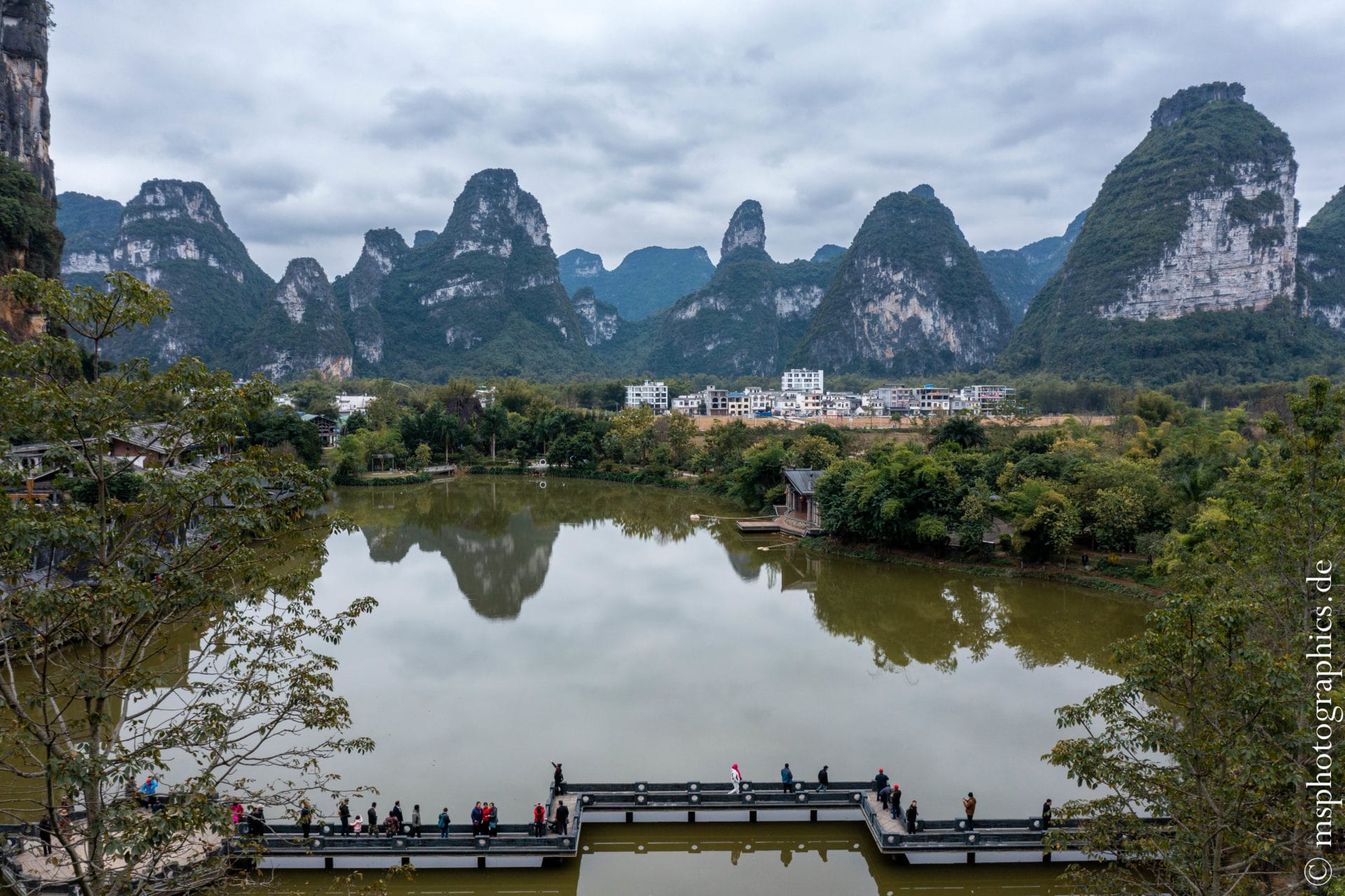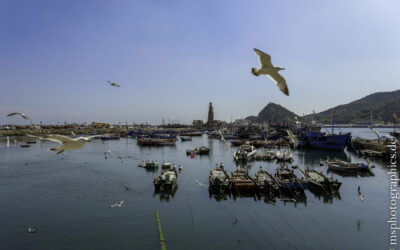Train Travel through Guangxi Province – Travel Planning:
Nine days were planned for the train journey through the southern Chinese province of Guangxi. The journey to Beihai, the starting point of the tour, was by plane from Beijing.
From Beihai we took the train to Guilin via Nanning and Liuzhou.
In Nanning, a detour to the border with Vietnam with a visit to the Mingshi village and the Detian waterfall was planned. Buses run daily from Nanning.
A trip to Guangxi is possible all year round, although the winter months can be cool to wet. In the winter months, from November to February, the sights are rarely visited, but warm clothing is necessary. As is usual in southern China, most hotels are not heated in winter.
The port city of Beihai:
From Beihai, we had planned to visit Weizhou Island. Unfortunately, a trip by ship was not possible during our stay due to storms and bad weather. So, we explored more of the Vietnamese influenced city center.
The pedestrian street in the historical part of Beihai is particularly attractive for a stroll in the morning. The small, colorfully furnished shops are best viewed when they are still relatively deserted.
In addition to numerous souvenir shops, tea shops and cafés invite you to taste local and international delicacies.
In Beihai you can find references to the Vietnamese character of the city on numerous corners. Especially in the Vietnamese quarter there are excellent restaurants where you can dine well at reasonable prices.
The metropolis of Nanning:
Nanning is the capital of the province of Guanxi and for us it was the starting point for a drive near the Vietnamese border.
In order not to have to take all our luggage with us, we took a hotel in Nanning right in the station building. The bus station, where the tours take place, is within walking distance of the train station.
The European Village is relatively easy to get to from the train station in Nanning. If you don't have much time in the city, you can spend time outdoors here.
In addition to buildings in the European style, there are small souvenir shops and a café where you can warm up in cooler temperatures.
Here you will find several restaurants that offer excellent local, national and international dishes.
Before or after eating, you can discover a lot in the streets and alleys and end the evening in a relaxing way.
Small stalls on the street sell small snacks and typical sweets for dessert.
The colorful lanterns create a special atmosphere.
Mingshi Village:
From Nanning we took the bus to Detian, where we booked a hotel for two nights. We organized the excursions with one of the local drivers directly at the bus station.
The prices for the trips, even for several days, are individually negotiable.
After checking in at the accommodation, we set off and visited the village of Mingshi.
Arrived in Mingshi, we continued on the water with small bamboo rafts. The village is wonderfully embedded in fascinating karst mountains.
Behind every bend in the river, new, wonderful views of the most diverse mountain and rock formations open up.
Before returning to land, one of the villagers greets you from the water with a typical song. Then you can take your time to look around the wooden house settlement built on the water.
The view from a bird's eye view is breathtaking. The karst landscapes of Guangxi have been part of the UNESCO World Heritage since 2014.
A descent into Tongling Gorge is an entertaining, multi-faceted hike. At the entrance you can take freshly prepared food for the road.
The descent is easy via stairs, the landscape is varied. Non-slip shoes are recommended.
The deeper you descend, the more interesting the landscape becomes. The path leads through a wooded rocky landscape, always along the water. You pass small pavilions that invite you to rest.
At the end of the path, you reach a cave through which the mountain water drains.
From the outside you have a great view of the waterfall before making your way back up.
On the way to our accommodation in Detian we passed another waterfall worth seeing.
The Detian – Ban Gioc waterfall at the border between China and Vietnam:
The next day we visited the Detian - Ban Gioc waterfall which is at the border between Vietnam and China.
The village of the same name, Detian, offers a few Chinese and Vietnamese restaurants, some of which also offer locally typical breakfasts. However, you will look in vain for Western dishes here.
The entrance to the waterfall can be easily reached by walking from the village.
First, the raft takes you towards the waterfall. Boats from China and Vietnam share the river. Vietnamese products, especially coffee, can also be purchased in the park.
After the raft ride, you walk up the mountain along the waterfalls.
Once at the top you can enjoy a magnificent view of the waterfall and the border river.
Detian-Ban Gioc Waterfall is the world's fourth largest waterfall located on the border of two countries.
We then took the bus back to Nanning and from there, in the late afternoon, to Liuzhou.
The surroundings of Liuzhou city:
In Liuzhou we spent one night at the Vienna International Hotel on Liuzhou Wuxing Pedestrian Street.
The hotel is in an excellent location right on a pedestrian zone. It is also just under four kilometers from the train station.
A very good breakfast is included in the price. In the pedestrian zone there are numerous restaurants, including international ones.
In Liuzhou sollte man es nicht verpassen, die Nudelsuppe „Luosifen“ zu probieren, die weit über die Stadtgrenzen hinaus Berühmtheit erlangt hat. Die Beste bekommt man in einem kleinen, unscheinbaren Laden in der Fußgängerzone, vor dem die längste Warteschlange und der größte Suppentopf stehen.
Also in Liuzhou there is a lot to do and visit. We decided to visit Luzhai Xiangqiao Karst National Geopark.
On an approximately one-and-a-half-hour circular route, you can once again immerse yourself in the fascinating karst world and discover bizarre rock formations.
In the afternoon we were able to observe the life of the local people in a small village outside of Liuzhou.
Located directly at the river, the village offers a lot to discover, such as a tree that has chosen an entire building as its habitat.
Away from the hustle and bustle of the big cities and away from mass tourism, people enjoy the peace and nature here.
In the late afternoon we drove back to the city and continued by train to Guilin.
Guilin on the Li River:
In Guilin, I reserved the Jingjing Hotel for three nights. It is right on the banks of the Li River. From there you can easily take trips on land or water.
In addition, the hotel offers the possibility of renting bicycles in order to be able to plan larger tours without any problems.
A delicious, rich breakfast buffet is also included in the price.
You can walk from the hotel along a disused railway line to discover the rural suburbs of Guilin and immerse yourself in life away from the big cities.
A walk through old country villages always offers a lot to see. The diverse ancient Chinese architecture in particular has its own special charm.
Closing time at an elementary school. In the late afternoon, the parents wait for their children in front of the school. We enjoyed the last rays of sunshine on the banks at the Li River before heading back to our accommodation.
Upon arrival at the hotel, there was another opportunity to go out on the Li River with the local fishermen and their cormorants.
Cormorant fishing has a long tradition in southern China.
We returned to the hotel from our fishing adventure just in time for sunset and could enjoy the colorful spectacle from the balcony.
If the weather cooperates, a sunset in the karst landscape of Guangxi is unique.
In the footsteps of the cormorant fishermen in Xiping:
The next day we wanted to learn more about the cormorant fishermen on the Li River and tried to find them along the river in the direction of Yangshuo.
Since traffic with bamboo rafts is greatly reduced in winter, we took a taxi to Xingping.
Xingping is a small town near the famous rock formation featured on the back of the 20 yuan bill.
Around noon we reached Xingping. Getting a taxi turned out to be a relatively difficult and rather overpriced affair.
We continued our search for refreshments in one of the small restaurants on foot.
The path led us out of town to a vantage point from which you can see the rock formation of the 20 yuan note particularly well.
In fact, the rocks look confusingly similar to the painting on the banknote. A fisherman's bamboo raft could also be seen, only the owner was still missing.
After a while of further searching, we were able to locate one of the oldest and most famous cormorant fishermen. In front of a small shed by the river, he enjoyed the quiet in his chair in the wintry afternoon sun.
Due to numerous television appearances and international documentaries about cormorant fishing, he and his brother are among the best-known personalities in China.
He talked about the camera teams that visited him from all over the world and filmed the fishing tradition in front of the karst mountain backdrop in Xingping.
He had nothing else planned that afternoon, so he decided to give us a personal demonstration of his skills.
After the demonstration he was available for all questions and answered them patiently.
Conclusion:
There is a lot to discover in the southern Chinese province of Guangxi. In addition to interesting cities, wild karst landscapes and impressive waterfalls, there is also the tradition of fishing with cormorants.
In China, the train is a comfortable means of transport for covering long distances quickly. In order to experience Guanxi on your own and not lose a lot of time, the bullet train was the best choice.
Of course, in winter the days are shorter and the temperatures colder, but you can escape the tourist rush. Boats line up on the Li River between Guilin and Yangshuo in summer. In my opinion, the impression you get in winter is more authentic and primal.
Guangxi is a province I highly recommend for exploring.











































































0 Comments